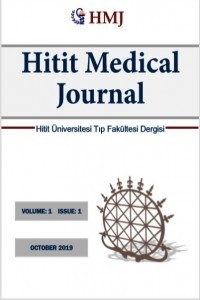Kemik İliği Biyopsilerinin Yeterlilik ve Kalitesinin Tanı Sürecine Etkileri
Amaç: Kemik iliği kor biyopsileri, kemik iliğinin hücresel özelliklerini, solid organ tümörü metastazlarını veya hematolojik malign tutulumlarını belirlemek için yapılan önemli incelemelerdir. Kor biyopsinin uzunluğu ve kalitesi doğru tanı konulmasını ve klinik süreci etkilemektedir. Bu çalışmada kemik iliği kor biyopsi uzunluğunun tanı sürecine olan etkisinin araştırılması amaçlanmıştır. Gereç ve Yöntem: Çalışmamızda bölümümüze son bir yıl içerisinde gelmiş olan kemik iliği biyopsi materyallerinin uzunlukları ve içerdikleri intertrabeküler alanlar mikroskop altında incelenmiş ve uzunlukları milimetre cinsinden ölçülmüştür. Kor biyopsiler; uzunlukları 15 milimetreye eşit ve/veya üzerinde ise yeterli grup, 15 milimetrenin altında ise yetersiz grup şeklinde iki gruba ayrılmıştır. Bulgular: Kor biyopsi uzunluğu 185 olguda (%48,9) yeterliydi. 194 olguda (%51,1) ise kemik iliği kor biyopsi uzunluğu 15 mm altında ölçüldü. Olguların 192 (%50,5) tanesine spesifik tanı (Miyeloproliferatif Neoplazi, Lenfoma tutulumu, Lösemi tanısı ve benzeri) konuldu. 188 olgunun (%49,5) ise selülaritesi değerlendirip görülen bulgular özetlendi. Spesifik tanı konabilen 192 olgunun 116 tanesinde (%62,4) biyopsi uzunluğu yeterli iken, spesifik tanı konulamayan 188 olgunun 118'inde (%62,8) biyopsi uzunluğu yetersizdi. Kor biyopsi uzunluğu ile spesifik tanı konulması arasında doğrudan kuvvetli bir ilişki vardı (p≤0,01). Sonuç: Kemik iliği kor biyopsi materyalleri güvenilir tanı için optimal büyüklükte alınmalı ve aspirasyon yaymaları ile birlikte değerlendirilmelidir. Ayrıca klinikopatolojik iş birliği tanı güvenirliğini artırmaktadır.
Anahtar Kelimeler:
hematopatoloji, kemik iliği, tanı, uzunluk, yeterlilik
The Effects of Adequacy and Quality of Bone Marrow Biopsy on the Diagnosis Process
Objective: Bone marrow core biopsy is an important examination to reveal the cellular features of the bone marrow, solid organ tumor metastases or involvement of hematological malignant diseases. The size and quality of the biopsy affects the diagnosis and clinical process. In this study, it was aimed to investigate the effect of the adequacy of bone marrow biopsy on the diagnostic process. Material and Method: In the study, the lengths of bone marrow biopsy materials and the intertrabecular areas they contain were examined under the microscope and their lengths were measured. Biopsies were divided into two groups as adequate group if their length is equal to and above 15 millimeters, and insufficient group if they are less than 15 millimeters. Results: There are 185 cases (48.9%) of bone marrow length over 15 mm (sufficient group). In 194 cases (51.1%), the bone marrow length was below 15 mm. We were able to give specific diagnosis (Myeloproliferative Neoplasia, Lymphoma involvement, diagnosis of Leukemia etc.) to 192 (50.5%) of the cases. We evaluated the popularity of 188 cases (49.5%) and summarized the findings we saw or just wrote the biopsy size in the comment section. While the biopsy length was sufficient in 116 (62.4%) of 192 cases with specific diagnosis, 118 (62.8%) of 188 cases without specific diagnosis, biopsy length was insufficient. There is a strong correlation between biopsy adequacy and specific diagnosis (p≤0.01). Conclusion: Bone marrow core biopsy samples should be taken in an optimal size for reliable diagnosis and evaluated with aspirations. In addition, clinicopathological cooperation increases diagnostic reliability.
Keywords:
Bone Marrow, Diagnosis, Hematopathology, Length, Qualification,
___
- 1. Lee SH, Erber WN, Porwıt A, Tomonaga M, Peterson C. ICSH guidelines for the standardization of bone marrow specimens and reports. Int Jnl Lab Hem 2008;30:349-364.
- 2. Stifter S, Babarović E, Valković Tet al. Combined evaluation of bone marrow aspirate and biopsy is superior in the prognosis of multiple myeloma. Diagn Pakhol 2010;18:5-30.
- 3. Brestoff JR, Toland A, Afaneh K et al. Bone Marrow Biopsy Needle Type Affects Core Biopsy Specimen Length and Quality and Aspirate Hemodilution. Am J Clin Pathol 2019;7:185-193.
- 4. Swerdlow SH, Campo E, Harris NL et al. WHO Classification of Tumours of Haematopoietic and Lymphoid Tissues. Fourth Edition. Lyon: International Agency for Research on Cancer 2017:16-27.
- 5. Kaur M, Singh Rana AP, Kapoor S, Puri A. Diagnostic value of bone marrow aspiration and biopsy in routine hematology practice. J Clin Diagn Res 2014;8:13-16.
- 6. Lynch DW, Stauffer SL, Rosenthal NS. Adequacy of powered vs manual bone marrow biopsy specimens: a retrospective review of sequential marrow aspirates and biopsies in 68 patients. Am J Clin Pathol 2015;143:535-539.
- 7. Merzianu M, Groman A, Hutson A et al. Trends in Bone Marrow Sampling and Core Biopsy Specimen Adequacy in the United States and Canada: A Multicenter Study. Am J Clin Pathol 2018;150:393-405.
- 8. Marinelli LM, Fang H, Howard MT et al. Bone Marrow Biopsy Operator Experience and Impact on Aspirate, Biopsy, and Ancillary Testing Quality. Mayo Clin Proc Inn Qual Out September 2018;2:241-247.
- 9. Maiti A, Short N J, Verstovsek S, Powers CA, Fullmer CA, Reyes SR, Bueso-Ramos CE. Quality and Cost Comparison of Powered Versus Manual Bone Marrow Biopsy Devices in Patients with Myelofibrosis. Leuk Lymphoma 2017;58:2508-2510.
- 10. Goldblum JR, Lamps LW, McKenney JK, Myers JL. Rosai and Ackerman`s Surgical Pathology 11th ed. Philadelphia: 2018;23:2047-2049.
- 11. Gilotra M, Gupta M, Singh S, Sen R. Comparison of bone marrow aspiration cytology with bone marrow trephine biopsy histopathology: An observational study. J Lab Physicians 2017; 9:182-189.
- Yayın Aralığı: Yılda 3 Sayı
- Başlangıç: 2019
- Yayıncı: Hitit Üniversitesi
Sayıdaki Diğer Makaleler
Hormon-Negatif Retroperitoneal Ekstra-Adrenal Paraganglioma
Pandeminin Gölgesinde Geçen 2 Yıl: Sorularla COVID-19
İmdat KILBAŞ, Elmas Pınar KAHRAMAN KILBAŞ, İhsan CİFTCİ
Kolon Kanseri Hücrelerinde (DLD-1) Pirolidin Türevi Bileşiğin Antiproliferatif Aktivitesi
Seda MESCİ, Melek GÜL, Tuba YILDIRIM
Servikal Füzyon için Alternatif Bir Teknik, Dairesel Şekilde Yerleştirilen Kemik Grefti: Teknik Not
Ahmet Gürhan GÜRÇAY, Hümeyra KULLUKÇU ALBAYRAK
Kemik İliği Biyopsilerinin Yeterlilik ve Kalitesinin Tanı Sürecine Etkileri
